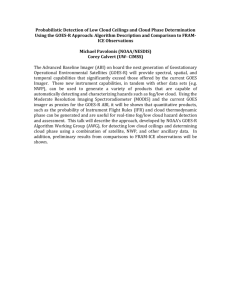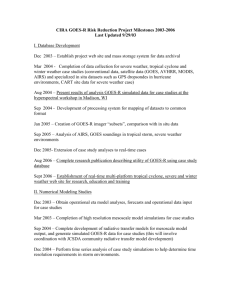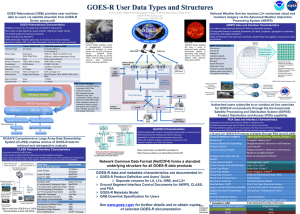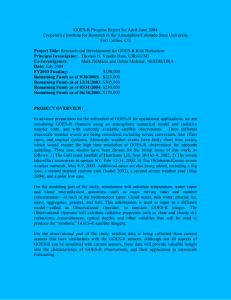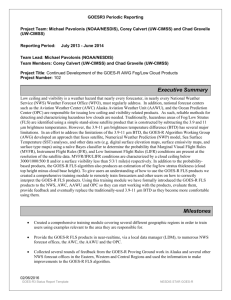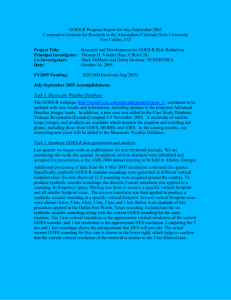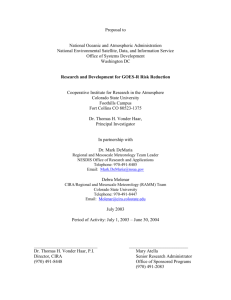GOES-R Direct Broadcast
advertisement
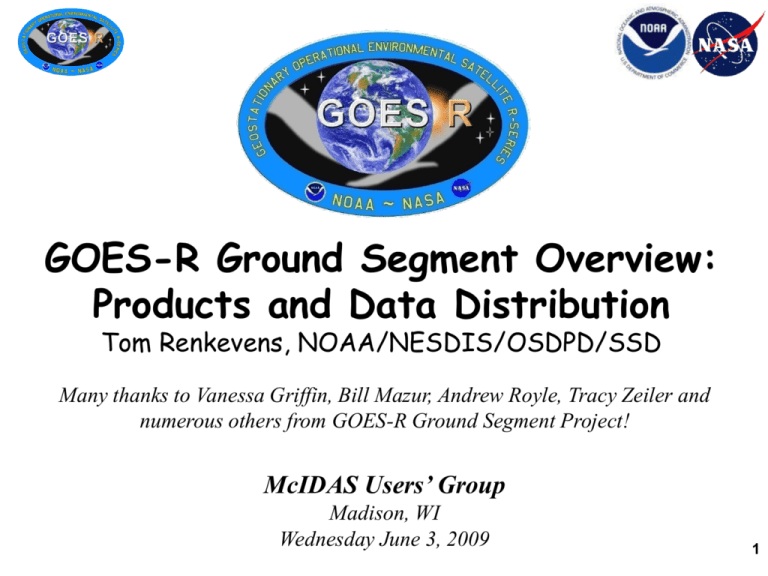
GOES-R Ground Segment Overview: Products and Data Distribution Tom Renkevens, NOAA/NESDIS/OSDPD/SSD Many thanks to Vanessa Griffin, Bill Mazur, Andrew Royle, Tracy Zeiler and numerous others from GOES-R Ground Segment Project! McIDAS Users’ Group Madison, WI Wednesday June 3, 2009 1 My McIDAS Background • Undergraduate student at Millersville University of PA 1987-1992 – One McIDAS workstation in 1988, expanded to 3 – 16 frames of imagery, several minutes to load a 4 frame loop – Called “sectors” • Graduate student at University of Oklahoma 1992-1995 – Resurrected McIDAS workstation from inoperable state • was using WEFAX hardcopy images for satellite data • Satellite (Synoptic) Analysis Branch and Satellite Service Division 1995-2005 – 24x7 use of McIDAS in products creation and dissemination • GOES-R 2005-2008 – Helped define Ground Segment specs • SSD 2008- current – User Services….. Disclaimer: Not an official spokesperson for GOES-R!!! 2 Topics • GOES Mission Overview • GOES-R Capabilities • GOES-R Ground Segment Overview • GOES-R Direct Broadcast – GOES Rebroadcast (GRB) – Emulated GOES Variable format (eGVAR) – High Rate Information Transmission/Emergency Managers Weather Information Network (HRIT/EMWIN) • GOES-R Products • McIDAS Connection 3 GOES Mission Overview • Provides geostationary coverage of Earth and space weather over the Western Hemisphere • Data distribution to users via – Direct broadcast – Terrestrial distribution (performed by NOAA’s Office of Satellite Data Processing and Distribution (OSDPD)) – Long-term Archive and Access • Primary products provided through imaging in visible, infrared (IR), and near-IR channels • Highly reliable operational system – Always “On,” always available 4 GOES-R Overview • GOES-R is the first in NOAA’s follow-on series of geostationary satellites, with initial launch expected in 2015 • Consists of new and enhanced instrumentation – Advanced Baseline Imager (ABI) – Geostationary Lightning Mapper (GLM) – Space Weather instruments • Space Environment In-situ Suite (SEISS) • Solar Ultraviolet Imager (SUVI) • Extreme ultraviolet and X-ray Irradiance Sensor (EXIS) • Magnetometer • GOES-R also will develop a new Ground Segment for satellite control and data processing 5 GOES-R System Capabilities Full Disk Image Imager bands Visible Resolution Near Infrared Resolution Infrared Resolution Bit Depth GOES I-P 30 minutes GOES-R 5 minutes 5 1 kilometer N/A 4 kilometer 16 0.5 kilometer 1 kilometer 2 kilometer 10 bits 12 bits – Visible, 14 bits Infrared Up to 106 Mbps (ABI: up to 67 Mbps) 3.6 Mbps Raw Instrument Data 2.62 Mbps Space Weather Geostationary Lightning Mapper Telemetry Planned Data Outage ~100 kbps N/A 4 kbps >300 hrs/year 5.5 Mbps 4 & 32 kbps <3 hrs/year 6 Instrument Downlink Comparison Fill Packets 120 100 Space Weather Data Mbps 80 60 GLM Data 40 20 ABI Data 0 GOES-R GOES I-P 7 Ground Segment Objectives • Support the primary mission operations goals to safely launch and safely operate the GOES-R series spacecraft • Design, develop, integrate and test the Ground Segment in a manner minimizing the GOES-R overall program costs • Minimize the impact to existing users during the transition to GOES-R services • Provide cost effective Ground Segment sustainment and maintenance once transitioned to Government operations • Provide cost effective and timely solutions to meet GOES-R evolving Ground Segment requirements – Open standards – Modular, scalable, flexible system design – Industry standard system and software engineering practices • Maintain compatibility with existing and enhanced versions of NOAA institutional systems required to support the GOES-R series spacecraft 8 Notional Functional Overview GOES East GOES West GOES-R Ground Segment Functional Elements Product Generation -- Enterprise Management -- GOES Rebroadcast (GRB) Mission Management Product Distribution GOES-R Ground Segment Facilities Remote Backup (RBU) NOAA Satellite NOAA Wallops Ground Operations Station (WCDAS) Facility (NSOF) User Community *CLASS: Comprehensive Large Array-data Stewardship System Archive and Access (CLASS*; GAS*) *GAS: GOES-R Access System (contained within ESPC: Environmental Satellite Processing Center ) Includes satellite mission operations Mission Management (telemetry and command), mission scheduling, mission state-of-health trending, satellite orbital analysis, and processing raw data to Level 0 (L0) Product Generation Includes processing L0 data to Level 1b (including calibration, and navigation & registration) and creation of GOES-Rebroadcast (GRB), creation of eGVAR, and creation of higher level data products (Level 2/2+) including operational formatted products. Product Distribution Includes distribution of GRB, distribution of KPPs to AWIPS, distribution and access to data and formatted products via the GOES-R Access Point, and distribution of data and formatted products to CLASS Enterprise Management Provides situational awareness of all functions of the GOES-R GS by monitoring and reporting the configuration of the security, networks, communications, and operational systems Infrastructure Includes telecommunications, facilities, and software infrastructure 9 GOES-R Product Distribution • AWIPS – Delivery of sectorized cloud and moisture imagery products to the AWIPS interface point via a dedicated path • GOES-R Access Subsystem (GAS) – Data ingest (no data processing) and distribution system for GOES-R products and data to authorized users – 7-day rolling storage (~23 TB) • Comprehensive Large-Array data Stewardship System (CLASS) – Long-term archive for GOES-R products (L1b, L2+) and data (L0, cal/val, algorithm software, documentation) • GOES Rebroadcast (GRB) – Data assembled from Level 1b in the form of CCSDS Transfer Frames for rebroadcast by the GOES-R satellites • Emulated GVAR (eGVAR) – Data selected and assembled from Level 1b for continuity of GOES operations and to facilitate transition from GOES-I/P to GOES-R. – Delivered to the IF interface point at WCDAS for rebroadcast by the legacy GOES-I/P system. – For transition purposes, assuming availability of non-operational GOES-I/P series spacecraft 10 Roles and Responsibilities Ground Segment Project Office Project Management, GS validation, system engineering, major acquisitions Ground Segment Contractor EM, MM, PG and PD development, segment integration, System Engineering, Integration and Test (SEIT) support for the entire GS Antenna Contractor Antennas/RF (Receive/Transmit, IF Switching, Signal Monitoring) OSD: Office of Systems Development GOES-R Access Subsystem (access point and 7-day data storage) Ancillary Data Relay System (“broker”) Domain-5 Development (HRIT modulation/encoding) CLASS (permanent archive) Facilities Upgrades Long-term Maintenance and Sustainment of GFP Operations Terrestrial Telecommunications Circuits/Services eGVAR interface Instrument Vendors L1b Algorithm Packages L1b Cal/Val through initial ops AWG: Algorithm Working Group L2+ Algorithm Packages, including: proxy data input and simulated output L1b Cal/Val (Post-Operational), L2+ Product validation OSO: Office of Satellite 11 GOES-R Ground Segment Contract Ground Segment Contract Baseline and Options Include: • Development of Core Ground Segment – – – – Mission Management Element Enterprise Management Element Product Generation Element Subset of Product Distribution Element • GOES Rebroadcast (GRB) • Advanced Weather Information Processing System (AWIPS) distribution – Internal telecommunications/networks (i.e., intra-site) – Option 1: Improved Latency / Option 2: Additional L2+ Products • Total Ground Segment Integration and checkout – Integration of GFP systems, including Antennas and GOES-R Access Subsystem (GAS) – Interfaces to external systems, including CLASS and Ancillary Data Relay System (ADRS) • Transition to NOAA Operations 12 Algorithm Working Group (AWG) • AWG is developing the Level 2+ Product algorithms to be used to produce the GOES-R data products. • AWG consists of a Government lead team from NESDIS/STAR and scientists from multiple aligned universities • Individual product algorithms are selected by the AWG from a ‘bestof-breed’ down-select from candidate algorithms meeting GOES-R product performance requirements • Algorithm Packages (AP) consist of the algorithm description, ancillary data requirements, sample software, test data, and test results. • APs are independently reviewed by the Government and then delivered to the GS Contractor for implementation • Operational implementation of the algorithms is the responsibility of the GS Contractor • Contractor implementation is initially verified using AWG provided test data and results • Contractor implementation is validated using live instrument data post-launch. 13 AWG Status • 14 Application Teams developing algorithms – Responsible for developing Algorithm Theoretical Basis Documents (ATBDs) and Algorithm Packages – Three ATBD deliveries: Draft, 80%, and 100% • Integrated Baseline Review (cost and schedule) completed Jul 2008 • Algorithm Integration Team integrating application team algorithms and software using consistent processing framework • Algorithm Development Status – Draft ATBDs delivered Sep 2008 – Baseline Products • 100% of Algorithm Design Reviews completed • 100% of Critical Design Reviews completed • 64% of Test Readiness Reviews completed – Option 2 Products (only) • 84% of Algorithm Design Reviews completed (97% after June 9) • 75% of Critical Design Reviews completed • 22% of Test Readiness Reviews completed 14 GOES-R Remote Backup (RBU) • RBU will provide back up for mission critical GOES-R functions – RBU will support two operational and one stored GOES R-series spacecraft – Mission Command and Control, and Mission Planning – Raw Instrument data acquisition and Level 0 processing – Level 1B processing and GRB production (no eGVAR from RBU) – Level 2+ product processing for the GOES-R key performance parameters (KPPs; i.e., Cloud and Moisture Imagery) • Product delivery to AWIPS – Data and product delivery to CLASS – RBU location will be in Fairmont, WV – NOAA is working with GSA Region 3 to acquire facility space for the RBU in which to locate the GS processing systems, and land on which to locate the antennas 15 Antennas • Antennas necessary to support GOES-R are being procured by the GSP through a stand-alone contract • Antenna systems (receivers, transmitters, IF switching and distribution, and signal monitoring) will be provided as Government Furnished Property (GFP) to the GS Contractor for integration with the core GS • NOAA Satellite Operations Facility (NSOF; Suitland, MD) – upgraded (existing) 9-meter L-band receive antennas • Wallops Command & Data Acquisition Station (WCDAS; Wallops, VA) – new 16.4-meter transmit/receive L-/S-/X-Band antennas – upgraded (existing)16.4-meter transmit/receive L-/S-/X-Band antennas • RBU – new 16.4-meter transmit/receive L-/S-/X-Band antennas • Draft RFP expected for released in June 2009 16 GOES-R Access Subsystem (GAS) • GAS provides real-time distribution of GOES-R Level-2+ products and is the user’s terrestrial product access point and 7-day temporary data store • GAS will provide both push and pull product delivery • GAS will support product subscriptions as well as ad-hoc product queries • GAS requirements call for support of 1000 simultaneously connected users, 200 simultaneous subscription requests, 100 simultaneous ad-hoc requests, and provide an initial continuous data delivery capability of 500 Mbps • Acquisition to be initiated in mid-2009 17 External Systems ADRS • • • ADRS collects and provides to the GS the ancillary data in order to produce many of the GOES-R Level-2+ products ADRS data requirements are defined by the AWG Application Teams GSP is providing a centralized enterprise ancillary data server to service both GOESR and legacy NESDIS systems HRIT/EMWIN • • • High-rate Information Transmission (HRIT) is the upgraded version of today’s LRIT For GOES-R, HRIT and NWS EMWIN (Emergency Managers Weather Information Network) are combined into one service produced by OSDPD GSP is providing an upgraded “Domain 5” in the HRIT distribution stream to establish compatibility with the GOES-R bit rate, IF distribution, and uplink frequency requirements DCS IF • • DCS functionality and performance will be maintained through the GOES-R era GSP is providing an upgrade to the IF signal handling to establish compatibility of GOES-R downlink frequency and IF with the requirements of the existing DCS demodulators 18 CLASS • Comprehensive Large-Array data Stewardship System (CLASS) is the NOAA enterprise archive and access system used by the NOAA National Data Centers for long-term data storage and retrospective data access • CLASS will store Level 0, Level 1b, and Level 2+ products – Subject to review and acceptance of each product for archive by the NOSC (NOAA Observing System Council) • GSP relies on enterprise capabilities and functionality of CLASS • GSP funds expansion of CLASS sufficient to ingest and store GOES-R data rates and volumes expected in excess of a Petabyte a year • CLASS System Requirements Review (for GOES-R) in Jun 2009 19 GSP Groups and Teams • Working Groups (WGs): • Integrated Product Teams (IPTs): – – – – Functional focus Crosscutting impact Independent reporting Examples: • Algorithm Validation • Cal/Val • Telecommunications • Data Engineering/Metadata • Integration • Security • Software Engineering – Product focus – Impact on a GS function or group of functions – Reports through the development oversight organization – Examples: • Access Subsystem • Antenna/RF/IF • Archive • AWIPS • eGVAR • Enterprise Management • Facilities / Installation • Launch Support • Transition to Operations • Product Generation Data Ingest 20 GOES-R Direct Readout Overview GOES-West 137° West GOES-East 75° West Direct Readout Users Remote Backup (RBU) Facility Fairmont, WV Command & control, raw data NOAA Satellite Operations Facility (NSOF) Suitland, MD Wallops Command and Data Acquisition Station (WCDAS) Wallops, VA GOES-R System Configuration 06/19/2008 v2 21 21 21 GOES-R Series Instruments Comparison GOES I-P GOES-R Significant Changes Imager ABI Greater resolution & Channels Sounder -- ABI to provide most legacy capabilities SXI SUVI Increased channels EUV & XRS EXIS Same Magnetometer Magnetometer Same HEPAD & EPS SEISS Greater energy ranges -- GLM Geostationary Lightning Mapper 22 GOES-R Series Instruments Comparison 23 GOES Downlink Frequencies 24 Current vs. Future Direct Readout Characteristics GVAR GOES Rebroadcast (GRB) Full Disk Image 30 minutes 5 minutes (Mode 4) 15 min (Mode 3) Other modes Rapid Scan, Super Rapid Scan 3000 km x 5000 km CONUS: 5 min 1000 km x 1000 km Mesoscale: 30 sec Polarization Linear Dual circular Receive Frequency 1685.7 MHz (L-band) 1690 MHz (L-band) Packetization GVAR Blocks CCSDS 133.0-B-1 Data Compression None Lossless compression Data Rate ~28.4 Mbps (31 Mbps link rate) 2.11 Mbps Antenna Coverage Earth coverage to 5° Earth coverage to 5° Data Sources Imager and Sounder SXI (MDL Link) SEM & Magnetometer (PCM/Telemetry link) ABI (16 bands), GLM, SEISS, EXIS, SUVI, MAG Space Weather None ~2 Mbps Lightning Data None ~0.5 Mbps 25 GOES-R Direct Broadcast Coverage (5° Elevation) 26 GOES Rebroadcast Service (GRB) • Provides full resolution products from all instruments – All data will be calibrated and navigated (“Level 1b”) – Some products, such as the GLM, are higher level products (“Level 2+”) • Replaces current GVAR service – 31 Mbps in GRB versus 2.1 Mbps of GVAR – DRO receive systems specified for same size antennas (G/T of 15.2 dB/K), however with significant changes: • Dual polarization (feed changes and dual receiver chain) • High-level modulation (e.g. QPSK, OQPSK, or 8-PSK (TBD)) • Forward error detection coding (Low Density Parity Check (LDPC) (TBR)) to reduce required C/No 27 GRB Dual Polarization Characteristics • Currently the L-band frequency spectrum of 1683 MHz to 1698 MHz is available for use by Geostationary Meteorological Satellites – As such it is a protected resource for the user community – Obtaining new frequencies anywhere in the RF spectrum is extremely difficult so maximizing the utilization of this resource is necessary • Dual Polarization is a well known technique for doubling the capacity of satellite channels – Notably at C-band for television distribution – No dual-polarization utilization data is available for the L-band frequencies currently used by weather satellites (1600-1700 MHz) • GOES-R program research indicates GRB will meet availability requirements under almost all conditions with margin – Extensive testing at the Wallops, VA Command and Data Acquisition Station characterized cross polarization effects for L-band dual circularly polarized links 28 GRB 99.99% Availability Coverage Interference Level GOES West 0.01% Exceedence of 22 dB interference level based on “Initial Bound Equation” determined by the conducted measurements and the ITU-R 0.01% rain rate for given areas in the GOES antenna footprint. GOES East The dark blue areas may see a reduction in link margin, but the link will still close. 29 Other GRB Service Design Considerations • Modulation type, coding and other link characteristics to be defined by Spacecraft contractor in conjunction with Government and Ground contractor through an Integrated Product Team (IPT) – DVB-S2 link characteristics and compatibility under consideration • Data formatting and product details to be defined by the GOES-R Ground Segment contractor in conjunction with GRB IPT; but will have – CCSDS packetization – Data types segregated between polarizations • LHCP to provide subset of imagery (0.64, 3.9, 6.185, 7.34, 11.2, 12.3, 13.3 micron channels); • RHCP to provide remaining 9 channels, plus all other instruments. 30 Emulated GVAR (eGVAR) • GOES-R will provide a limited capability to produce emulated GVAR (eGVAR) Imagery to Users capable of receiving today’s GVAR data stream – Relies on availability of a spare satellite from the GOES N/O/P series to broadcast to users. – Transmitted signal will have GVAR characteristics: • Same transmit frequency and power levels • Same GVAR format • Five channels from the ABI (0.64, 4.9, 6.19, 11.2, 13.3 µm) – Similar to the GOES Imager channel wavelengths • Imagery will be mapped to GOES N/O/P resolution • No Sounder data • Limited to Full Disk scenes on the half-hour – No Mesoscale data 31 eGVAR & GRB Flows GOES-R Satellite GOES-N/O/P Series Satellite GOESN/O/P RF Mission Management Mission Management Product Generation (GRB) GOES-N/O/P SSGS Product Generation (GRB, eGVAR) Remote Backup Fairmont, WV WCDAS Wallops, VA eGVAR User Legend Instrument Raw Data downlink GRB relay uplink eGVAR relay uplink GRB RF Broadcast eGVAR RF Broadcast Terrestrial/Network Comm GRB User 32 One Concept for a GRB Small User Receive System Downconverter Data & Demodulator Aggregator Antenna & Feed Filter 90 deg Hybrid LNA Demodulator RHCP Data Handling Filter LNA LHCP DVB-S2* PCI Card Receiver Demodulator Storage •~$550/polarization – $~200 for a PCI-Card –$350 for an equivalent new PC from Dell Data Aggregator •$350 for an equivalent new PC from Dell * Use of DVB-S2 is under consideration for GRB—currently TBD 33 HRIT/EMWIN • Individual Low Rate Information Transmission broadcast (LRIT) and the Emergency Managers Weather Information Network broadcast (EMWIN) combined onto common carrier • Provides growth path for both Services to a combined 400 Kbps information rate – LRIT currently 128 Kbps information rate – EMWIN currently: 9.6 Kbps (GOES 11&12), 19.2 Kbps* for GOES 13-15. • Will utilize BPSK modulation w/ convolutional and Reed-Solomon coding – Same as LRIT, but higher data rate – Allows maximum EIRP from satellite due to Power Spectral Density restrictions – EMWIN Users modulation type changes from uncoded FSK (GOES I-M), from coded OQPSK (GOES-NOP) to coded BPSK 34 HRIT/EMWIN (Cont.) • Name change to High Rate Information Transmission (HRIT) required by CGMS categorization of services • Virtual Channel Data Units used to separate EMWIN and LRIT data: – Virtual channels used in LRIT today • Prototype Software Defined Radio developed and demonstrated by Aerospace Corporation – One hardware/software configuration can receive all current and future EMWIN, LRIT and HIRT/EMWIN signals – Technology demonstration to proves low cost, PC-based terminals are possible for all data rates and modulation types 35 GOES-R Products List Observables- Product Sets 1 & 2 Baseline Products Aerosol Detection (incl Smoke & Dust) Suspended Matter / Optical Depth Volcanic Ash: Detection & Height Cloud & Moisture Imagery Cloud Optical Depth Cloud Particle Size Distribution Cloud Top Phase Cloud Top Height Cloud Top Pressure Cloud Top Temperature Hurricane Intensity Lightning Detection: Events, Groups, & Flashes* Rainfall Rate / QPE Legacy Vertical Moisture Profile Legacy Vertical Temperature Profile Derived Stability Indices Total Precipitable Water Clear Sky Masks Radiances* Downward Solar Insolation: Surface Reflected Solar Insolation: TOA Derived Motion Winds Fire / Hot Spot Characterization Land Surface (Skin) Temperature Snow Cover Sea Surface Temperature Energetic Heavy Ions* Magnetospheric Electrons and Protons: Low Energy* Magnetospheric Electrons and Protons: Medium & High Energy* Solar and Galactic Protons* Geomagnetic Field* # GOES-R GS EndProducts Observables- Product Sets 3 & 4 Option 2 Products # GOES-R GS End-Products 6 4 2 54 4 6 6 6 4 4 2 12 Aerosol Particle Size Aircraft Icing Threat Cloud Ice Water Path Cloud Imagery: Coastal Cloud Layers / Heights and Thickness Cloud Liquid Water Cloud Type Convective Initiation Enhanced “V” / Overshooting Top Detection Low Cloud and Fog Turbulence Visibility 2 2 6 2 6 6 6 4 4 2 4 2 2 6 6 30 2 6 6 6 4 36 8 6 6 6 1 1 Probability of Rainfall Rainfall Potential Total Water Content Absorbed Shortwave Radiation: Surface Downward Longwave Radiation: Surface Upward Longwave Radiation: Surface Upward Longwave Radiation: TOA Ozone Total SO2 Detection Flood/Standing Water Ice Cover/Landlocked Snow Depth Surface Albedo Surface Emissivity Vegetation Fraction: Green Vegetation Index 2 2 6 2 4 4 4 4 2 4 2 6 2 2 2 2 1 Currents 4 1 1 Currents: Offshore Sea & Lake Ice: Age 4 2 36 34 - Current GOES-R Product List Baseline Products: Product Sets #1 & #2 Aerosol Detection Detection (including (including Smoke Smoke & & Dust) Dust) 11 Aerosol Suspended Matter Matter // Optical Optical Depth Depth 11 Suspended Volcanic Ash: Ash: Detection Detection and and Height Height 22 Volcanic Cloud & & Moisture Moisture Imagery Imagery (KPPs) (KPPs) 11 Cloud 2 Geomagnetic Field 22 11 11 22 11 # Rainfall Rate Rate // QPE QPE Rainfall Legacy Atm. Atm. Vertical Vertical Moisture Moisture Profile Profile Legacy Legacy Atm. Atm. Vertical Vertical Temp Temp Profile Profile Legacy Derived Stability Stability Indices Indices Derived Total Precipitable Precipitable Water Water Total Clear Sky Sky Masks Masks 11 Clear 11 11 11 11 11 11 Cloud Optical Optical Depth Depth Cloud Cloud Particle Particle Size Size Distribution Distribution Cloud Cloud Top Top Phase Phase Cloud Cloud Top Top Height Height Cloud Cloud Top Top Pressure Pressure Cloud Cloud Top Top Temperature Temperature Cloud Hurricane Intensity Intensity 22 Hurricane 1 Radiances # Downward Solar Solar Insolation: Insolation: Surface Surface 22 Downward Reflected Solar Solar Insolation: Insolation: TOA TOA 22 Reflected Derived Motion Motion Winds Winds 22 Derived Fire // Hot Hot Spot Spot Characterization Characterization 22 Fire Snow Cover Cover 22 Snow Sea Surface Surface Temps Temps 22 Sea 1 Energetic Heavy Ions # 1 Mag Electrons & Protons: Low Energy # 1 Mag Electrons & Protons: Med & High Energy # 1 Solar & Galactic Protons # 1 Solar Flux: EUV # 1 Solar Flux: X-Ray # 1 Solar Imagery: X-Ray # Lightning Detection Detection 21 Lightning Land Surface Surface (Skin) (Skin) Temperature Temperature 22 Land ABI – Advanced Baseline Imager Continuity of GOES Legacy Sounder Products from ABI SEISS – Space Env. In-Situ Suite EXIS – EUV and X-Ray Irradiance Sensors GLM – Geostationary Lightning Mapper Magnetometer 25 - AWG L2+ Products # 9 - Instrument Vendor L1b Products SUVI – Solar extreme UltraViolet Imager 37 34 - Current GOES-R Product List Option 2 Products: Product Sets #3 & #4 3 Aerosol Particle Size 4 Probability of Rainfall 4 Rainfall Potential 4 Aircraft Icing Threat 3 Cloud Imagery: Coastal 3 Cloud Layers / Heights & Thickness 3 Cloud Ice Water Path 3 Cloud Liquid Water 3 Total Water Content 3 Absorbed Shortwave Radiation: Surface 3 Downward Longwave Radiation: Surface 3 Cloud Type 3 Convection Initiation 4 Enhanced “V” / Overshooting Top Detection 3 3 3 3 3 3 4 4 4 Surface Albedo Surface Emissivity Vegetation Fraction: Green Vegetation Index Currents 4 4 4 4 4 4 Currents: Offshore Sea & Lake Ice / Age Sea & Lake Ice / Concentration Sea & Lake Ice / Extent Sea & Lake Ice / Motion Ice Cover / Landlocked: Hemispheric 4 Snow Depth (Over Plains) Upward Longwave Radiation: Surface Upward Longwave Radiation: TOA Ozone Total SO2 Detection 3 Low Cloud & Fog 4 Flood / Standing Water 3 Turbulence 4 Visibility ABI – Advanced Baseline Imager Continuity of GOES Legacy Sounder Products from ABI 32 - AWG L2+ Products SEISS – Space Env. In-Situ Suite EXIS – EUV and X-Ray Irradiance Sensors Low Maturity Algorithm GLM – Geostationary Lightning Mapper Magnetometer 2- Deleted L2+ Products SUVI – Solar extreme UltraViolet Imager 38 The McIDAS Connection • GOES-R Functional and Performance Specification: – GSFPS-3149 • The GS will produce products in NetCDF (currently version 4) and McIDAS for Atmosphere, Land, and Ocean Products, and NetCDF (currently version 4) and FITS for Space Products • GOES-R Applicable Document: – SSEC Storing Satellite Imagery In McIDAS Data Structures. Feb 1997 N/A - Web-based • http://www.ssec.wisc.edu/mcidas/doc/misc_doc/area2.html 39 Summary • System Requirements, communications requirements, and the Ground Segment architecture have been defined for the entire system, including Direct Broadcast Services • Detailed definition of communication link characteristics have not yet been fully finalized, and will be refined through the Spacecraft and Ground Segment design processes following contract awards • GRB will replace current forms of instrument data broadcast and provide full resolution, calibrated, navigated, near real-time direct broadcast data 40 Summary of SEB Activities • Initial Proposals received Jul 2008 • Final Proposal Revisions received Feb 2009 • Contract Award expected in Jun 2009 • Additional Information on the GS acquisition is available from: – FedBizOpps http://www.fedbizopps.gov/ • DG133E-08-RP-0068 • Additional GOES-R technical documentation is available online at the official GOES-R website: http://www.GOES-R.gov 41 Backup Slides 42 GOES-R Instrument Suite The GOES-R instrument suite will offer new direct broadcast data types and products from a enhanced suite of on-board instruments, observing atmospheric, ocean, land, lightning, and space weather. ABI The Advanced Baseline Imager (ABI) is a multi-channel (visible through infrared) passive imaging radiometer designed to provide variable area imagery and radiometric information of the Earth’s surface, atmosphere and cloud cover. The ABI provides moderate spatial and spectral resolution at high temporal and radiometric resolution to monitor rapidly changing weather. ABI is designed to measure solar reflected and emissive radiance simultaneously in 16 spectral channels. The ABI can complete a full Earth disk scan in 5 min and a 1000 x 1000 km mesoscale scan in 30 sec. GLM The Geostationary Lightning Mapper (GLM) will detect the frequency and location of lightning activity. The GLM instrument will not directly produce images, but will provide event data to the ground system, which will use spacecraft telemetry, orbit and attitude information and other data to generate calibrated and navigated products mapping lightning discharges over the hemisphere. SUVI The Solar Ultraviolet Imager (SUVI) provides narrowband imaging in the soft X-ray to EUV wavelength range at a high cadence. It replaces the current GOES-M/P series Solar X-ray Imager (SXI) instrument and represents a change in both spectral coverage and spatial resolution over the SXI. EXIS The Extreme ultraviolet and X-ray Irradiance Sensor (EXIS) comprises two distinct instruments. The Extreme Ultraviolet Sensor (EUVS) is a full disk FOV (40 arc min) detector measuring integral solar EUV flux. The X-ray Sensor (XRS) measures the full disk integral solar X-ray flux and will monitor the duration and magnitude of X-ray flares. The EXIS and SUVI are mechanically integrated on a common Sun-pointing platform. SEISS The Space Environment In-Situ Suite (SEISS) is a set of energetic particle sensors that monitor the charged particle environment at geosynchronous orbit. The SEISS consists of the Energetic Heavy Ion Sensor (EHIS), the Magnetospheric Electron and Proton Sensor (MPS) and the Solar and Galactic Proton Sensor (SGPS). MAG The Magnetometer (MAG) measures the magnitude and direction of the Earth's magnetic field in three orthogonal directions. These 3/12/2016 data provide geomagnetic variations and a map of the space environment that controls charged particle dynamics in the outer region43 of the magnetosphere. GOES Rebroadcast Components Left-Hand Circular Polarization (LHCP) Data ABI 0.64 μm band* ABI 3.9 μm band* ABI 6.185 μm band* ABI 7.34 μm band ABI 11.2 μm band* ABI 12.3 μm band ABI 13.3 μm band* Right-Hand Circular Polarization (RHCP) Data Potential Uses Daytime cloud imaging Surface and cloud/fog at night; fire Upper tropospheric water vapor Lower tropospheric water vapor; SO2 detection Total water; clouds Total water; ash; sea surface temperature Air temperature; cloud heights ABI 0.47 μm band ABI 0.865 μm band ABI 1.378 μm band Daytime aerosol-on-land/coastal water mapping Daytime vegetation; aerosol-on-water Daytime cirrus clouds ABI 1.61 μm band ABI 2.25 μm band ABI 6.95 μm band ABI 8.5 μm band ABI 9.61 μm band ABI 10.35 μm band Daytime cloud water; snow Daytime land/cloud properties; particle size; vegetation Middle tropospheric water vapor Total water for stability; cloud phase; dust; SO2 Total ozone Supports 11.2 and 12.3 μm bands to enhance cloud particle size measures Lightning Detection: Events & Flashes Energetic Heavy Ions Geostationary detection of lightning events and flashes Measures energetic heavy ions (10 - 200 MeV/n) in 4 mass groups: He, (C,N,O),Ne-S, & Fe Magnetospheric Electrons and Protons: Low Energy Measures electrons and protons in the 30 eV - 30 keV range Magnetospheric Electrons and Protons: Medium & High Energy Measures electrons in the 30 keV - 4 MeV range Measures protons in the 30 keV - 1 MeV range Solar and Galactic Protons Measures solar energetic protons and galactic cosmic ray protons (1 MeV - 500 MeV Geomagnetic Field Solar Flux: EUV Measures Earth’s magnetic field and its variations at geosynchronous orbit Measures disk-integrated solar extreme ultraviolet flux Solar Flux: X-Ray Measures disk-integrated solar X-ray flux Solar Imagery: X-Ray Measures solar images in the X-ray region * Included in eGVAR Advanced Baseline Imager (ABI) Geostationary Lightning Mapper (GLM) Solar Ultraviolet Imager (SUVI)/ Extreme ultraviolet and X-ray Irradiance Sensor (EXIS) Space Environment In-Situ Suite (SEISS) Magnetometer 44
